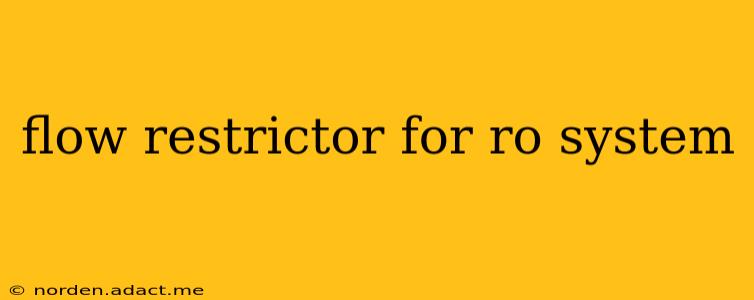Reverse osmosis (RO) systems are increasingly popular for providing clean, safe drinking water. However, optimizing their performance requires understanding the crucial role of a flow restrictor. This comprehensive guide explains what a flow restrictor is, why it's essential, how it works, and how to choose the right one for your RO system.
What is a Flow Restrictor in an RO System?
A flow restrictor, also known as a flow control valve or pressure regulator, is a small device installed in your RO system's output line. Its primary function is to regulate the water flow rate from the RO membrane. It's a critical component, ensuring the system operates efficiently and prevents damage to the membrane. Think of it as a carefully calibrated bottleneck, managing the water's journey from purified to ready-to-drink.
Why is a Flow Restrictor Necessary?
The RO membrane is a delicate component. Without a flow restrictor, the high water pressure could damage the membrane, shortening its lifespan and compromising the quality of your purified water. A flow restrictor maintains the proper operating pressure, maximizing the membrane's efficiency and extending its useful life. It also ensures a consistent flow of purified water, preventing fluctuations that might affect the taste or purity of your drinking water.
How Does a Flow Restrictor Work?
A flow restrictor works by creating resistance to the water flow. This resistance reduces the pressure on the downstream side of the membrane. This controlled pressure is essential for optimal RO performance; too much pressure can damage the membrane, while too little results in insufficient purification. The precise design of the restrictor determines the amount of resistance and, consequently, the final flow rate.
Choosing the Right Flow Restrictor: Factors to Consider
Selecting the appropriate flow restrictor is vital for your RO system's performance. Several key factors influence this decision:
1. What is the GPD (Gallons Per Day) rating of your RO membrane?
The GPD rating specifies the amount of water the membrane can process daily. The flow restrictor needs to be compatible with this rating to ensure optimal performance and prevent over-pressurizing the membrane. A membrane with a higher GPD rating will typically require a flow restrictor that allows for a higher flow rate.
2. What is the operating pressure of your RO system?
The system's operating pressure directly impacts the flow rate. The flow restrictor needs to be chosen to maintain the ideal operating pressure range recommended by the RO membrane manufacturer. This information is usually found in the membrane's specifications.
3. What is the desired flow rate of purified water?
While you need to respect the membrane's GPD rating and operating pressure, you'll also want a flow rate that meets your household's needs. If you have a larger household or use a lot of filtered water, you might need a flow restrictor that allows for a higher flow rate.
Troubleshooting Common Flow Restrictor Issues
Problems with your flow restrictor can manifest in several ways:
Low Water Flow:
This could indicate a clogged or damaged flow restrictor. Try replacing it.
No Water Flow:
This is often due to a completely blocked flow restrictor, a problem with the RO system itself, or a faulty membrane.
Inconsistent Water Flow:
This points to a malfunctioning flow restrictor or other components within the RO system.
In all cases, carefully review your system's instructions, or consult a qualified technician.
How to Replace a Flow Restrictor
Replacing a flow restrictor is usually a straightforward task. Turn off the water supply to your RO system. Locate the flow restrictor (often a small, usually clear, plastic tube). Carefully remove and replace it with a new one, ensuring a tight seal to prevent leaks.
Remember to always consult your RO system's user manual for specific instructions and recommendations.
This guide provides a comprehensive overview of the flow restrictor's importance in an RO system. By understanding its function and choosing the right one, you can ensure your system operates efficiently and provides clean, healthy water for years to come. If you're still unsure about any aspect of your RO system, seeking guidance from a professional is always a good idea.
